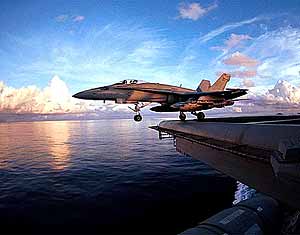23.04.2009
April 16, 2009 (the date of publication in Russian)
Maxim Kalashnikov
USSR-USA: AFGHAN PARALLELS
Barack Obama's approach to military industry resembles Gorbachov's perestroika
 Pumping huge amounts of money into the Afghan-Pakistani adventure, Barack Obama's administration slashes advanced programs of military research and production. The abandoned programs could create hundreds thousand jobs and guarantee a technological breakthrough. America's geopolitical rivals are understandably satisfied with this approach, still wondering what the shift implies – stupidity, or the beginning of the end of the most powerful military machine.
Pumping huge amounts of money into the Afghan-Pakistani adventure, Barack Obama's administration slashes advanced programs of military research and production. The abandoned programs could create hundreds thousand jobs and guarantee a technological breakthrough. America's geopolitical rivals are understandably satisfied with this approach, still wondering what the shift implies – stupidity, or the beginning of the end of the most powerful military machine.
†
RECALLING GORBY
Ascending to the post of CPSU General Secretary in 1985, Mikhail Gorbachov reinforced the Soviet contingent in Afghanistan with additional spetsnaz (special forces) units. Increasing expenses for war, the General Secretary simultaneously slashed state financing of advanced aerospace programs. Though in nominal value ($3-4 billion), Soviet expenses for Afghanistan were ten times smaller than the current US spending for military operations in the same area, the parallels are obvious.
Reproducing the traditions of the Soviet bureaucracy, the White House classified the distribution of the 2010 military expenses. Even in the times of George W. Bush, the war budget was more transparent. The total amount of military expenses comprises $537 billion, exceeding the 2008 figure by $24 billion. The fact that most of the budget is going to be wasted for the Afghan venture is obvious from the announced contraction of advanced military industrial programs.
The idea to slash the program of Gerald Ford-type aircraft carriers, most sophisticated and costly in the history of military production (they were supposed to replace the Chester Nimitz series of 1960s) is perfectly justified: the United States doesn't have to confront the once powerful Soviet Navy, while China is not expected to create a comparable fleet within decades. The existing naval airbases are still usable for targeting objects of potential adversaries from the sea.
However, the decision to slash the program of Zumwalt DDG-1000 destroyers can be interpreted as undoubted regress of the US military strategy. The design of these ships (actually, light missile 12,000 ton cruisers) enabled them to confront a strong supramarine fleet of an advanced adversary, to affect distant mainland targets from coastal waters, concentrating most innovative technologies. Despite their high costs ($5.6 billion each), construction of the two leading destroyers would absorb only one quarter of the annual expenses for the Afghan adventure. The most fantastic invention Ц an electromagnetic railgun with a range over 100 km and GPS-managed projectiles Ц is also slashed.
One more loss of the strategic military program is the curtailment of the stealth fighter of the F-22 Raptor type. The aircraft is costly but highly advanced, enabling to acquire advantage by quality, not quantity. The decision to curb this program, according to Rep. (R) Tom Price, is going to eliminate 25,000 qualified jobs. The curtailment of the Globemaster transport aircraft program will contribute to layoffs in Boeing Corporation.
The reduction of spending for the national ABM system that perfectly corresponds with the priorities of US military strategy is even more stunning. It is similarly hard to interpret the decision to suspend the program of equipping Alaska-based ABM facilities with MKV units, capable of intercepting multiple warheads of Russia's Topol-M missiles and missiles with false warheads.
Curtailment of air-based laser ABM systems also favors the Russian side, as the lasers were designed as the pivot of space-based combat systems.
Defense Secretary Robert Gates assures that the United States is not going to continue costly programs designed for large-scale warfare, concentrating on technique targeting irregular guerilla forces, like the Talibs.
Still, these economizing initiatives produce an odd impression.
†
THE DEFENSE BUDGET TO BE REDISTRIBUTED Ц AND EMBEZZLED?
In fact, regardless from the type of anti-guerilla weaponry the United States is going to use in Afghanistan and Pakistan, warfare is likely to be reproduced, unless Washington decides to exterminate the 150mln population of the area, which is doubtful. It is noteworthy that expansion of the campaign would require an extremely expensive effort of capture and withdrawal of nuclear weapons from the disintegrating Pakistan.
It is commonly believed that US bases, deployed in Afghanistan, enable Washington to hold the whole Central Asia in the breechsight. But aren't these bases too expensive? In order to maintain them, the United States has to keep a 100,000 contingent of land forces in the area, and pump more billions (along with economic assistance) into the marionette government of Afghanistan, which conveniently embezzles these donations. And nevertheless, the US forces will eventually have to pull out of the region.
Huge expenses, currently allocated for the Afghan war, could serve as vital support for national industry Ц and not only for novel Raptors but also for breakthrough civil programs in energy and auto production. These advantages are victimized for the sake of face-saving in the Afghan quagmire.
Not surprisingly, the logic of Obama's government reminds the desperate policy of Mikhail Gorbachov's Politburo which eventually brought the Soviet statehood to disintegration. This irrational approach raises concern of domestic stability in the United States that may result either in disintegration Ц an option considering loss of control over the military nuclear potential, or a coup d'etat ensuing an unprecedented shift to a military dictatorial regime.
Number of shows: 2171
 ENG
ENG 

 ENG
ENG 
